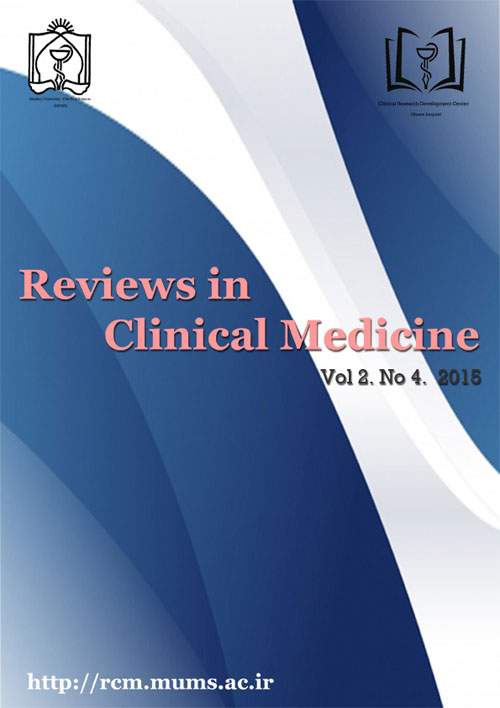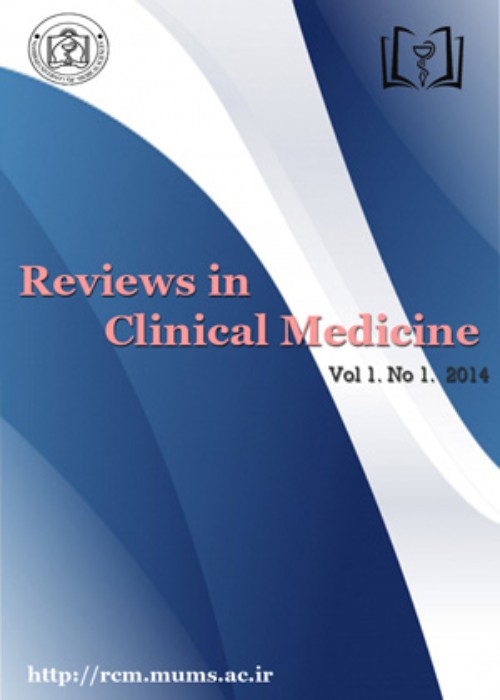فهرست مطالب

Reviews in Clinical Medicine
Volume:2 Issue: 4, Autumn 2015
- تاریخ انتشار: 1394/06/24
- تعداد عناوین: 12
-
Pages 164-167IntroductionNeuroblastoma is known as one of the most common solid tumors in children, which is recently under the investigation for the expression of CD133, a marker of cancer stem cells. Revealing the prognostic value of CD133 marker expression is important in predicting the outcome and survival of neuroblastoma patients. In this systematic review, we aimed to review the studies on association between CD133 expression and other peripheral neuroblastic tumor prognostic factors.MethodsPubMed was searched for the relevant articles. No time and language limitation were included in our search strategy. Data regarding the patients’ number and age, tumor stage, histology and CD133 expression were extracted.ResultsOverall, only 4 relevant articles were retrieved. One articles revealed the positive association between CD133 expression in neuroblastoma samples and its resistance to chemotherapy treatment. Three of the included articles showed the positive relation between CD133 expression rate and tumor stage progression. Two of the included studies revealed much worse survival of the neuroblastoma patients with more expression of CD133.DiscussionBased on included studies, CD133 expression is positively related with poor outcome prognosis in patients, more advanced tumor stage, shorter disease-free survival and overall survival.ConclusionAlthough the expression of CD133 has shown increasing trend by advancing the neuroblastoma tumor stage, more studies with larger sample size are needed to accurately reveal the relation.Keywords: Cancer stem cells, CD133, Neuroblastoma
-
Pages 168-173IntroductionThe prognostic value of Her2-positive expression has been investigated for malignancies such as breast cancer. We aimed to study the association between Her2 gene overexpression and clinical progression of hormone-independent prostate cancer.MethodsPubMed was searched to obtain the relevant articles without language or date limit. Reference list of the relevant articles was also searched to prevent missing any relevant article. Data were extracted regarding the patients’ survival and disease-free survival.ResultsOverall, 15 articles were obtained, which studied the prognostic value of Her2 overexpression in patients with prostate cancer. Based on obtained hazard ratio and calculated log-rank test, overexpression of Her2 was significantly associated with disease recurrence, overall survival and cause-specific survival.DiscussionHer2 expression can be considered as a mortality rate indicator in patients with metastatic prostate cancer and higher risk of disease recurrence (increase in PSA level) has been suggested in these patients with over expression of Her2.ConclusionDespite various differences in included articles regarding methodology, results, sample size and individual differences, Her2 overexpression showed a positive relation with poor prognosis of prostate cancer regarding survival and disease recurrence.Keywords: Disease free survival, Overall survival, Prostate cancer
-
Pages 174-177Constructing successful anastomosis is an important concept in gastrointestinal tract surgeries, which can be affected by various factors such as preoperative bowel condition, intra- and postoperative complications, bleeding and the device characteristics. Suturing, stapling and compression anastomosis are different techniques. Despite the invention of compression anastomosis, which goes back almost two centuries, this method has not obtained the popularity of the suturing and stapling anastomosis and further studies are required. Designing methods and devices with no drawbacks might reduce the complications associated with anastomosis as the alternative to suturing and stapling anastomoses. Several materials can be used as reinforcement materials, which can improve the consequences of the stapled anastomosis. In addition to reinforcement materials, other forms of supports have been proposed, which might be capable of reducing the postoperative complications of anastomosis. In this study, we briefly review various types of anastomotic techniques and associated complications in different types of gastrointestinal surgeries.Keywords: Gastrointestinal tract, Surgical anastomosis, Surgical staple, Sutures
-
Pages 178-182Cardiovascular is the major cause of death in chronic kidney disease and end-stage renal disease. The cardiovascular mortality rate of patients with renal impairment is evaluated to be higher than general population. Coronary artery disease seems to be an important type of cardiovascular complication among patients with chronic kidney disease and end-stage renal disease before the renal replacement therapy. Due to the strong association between chronic kidney disease and the incidence of coronary artery disease, accurate screening, diagnosis, and management of cardiovascular complications would be essential in patients at different stages of renal dysfunction. Despite the need for the comprehensive knowledge about different aspects of coronary artery disease in patients with renal failure, there is not sufficient evidence regarding the pathophysiology, ideal diagnosis, and treatment strategies for coronary heart disease in population with chronic kidney disease. In this study, we briefly reviewed the existing literatures about the possible screening, diagnosis, and the treatment approaches of risk of coronary heart disease in patients with kidney dysfunction.Keywords: Chronic kidney disease, Coronary heart disease, End stage renal disease, Mortality
-
Pages 183-185Morphea is a skin disorder that leads to the sclerosis of the dermis and subcutaneous tissue. In epidemiologic studies, the incidence rate of approximately 0.4 to 2.7 per 100,000 people has been reported that is equal in adults and children. Based on clinical findings of disease and presentations, morphea disease has been divided into four major types including plaque-type, linear, generalized and a miscellaneous group with morphologically distinct phenotypes. Overall, plaque-type is the most common type of morphea. This disease is characterized by three main histopathologic features that include deposition of collagen in the dermis sometimes with extension to subcutis, vascular changes and an inflammatory cell infiltration, particularly in early lesions. Morphea is a multifactorial process that its main underlying cause is not completely known but the most common causes related to the genesis of morphea including trauma, radiation, medications, infection, autoimmunity and microchimerism. In this paper, we review the literature about the role of infection in the genesis of morphea.Keywords: Borrelia, Cytomegalovirus, infection, Morphea
-
Pages 186-190IntroductionDermoid/Epidermoid cysts are rare pathologic lesions that may involve the floor of the mouth. Infection and inflammation of the cyst can produce a clinical picture very similar to the submandibular and submental abscesses with odontogenic origin. Dermoid/epidermoid cysts are on the floor of the mouth with submental or submandibular component can be mistaken for odontogenic infections.MethodsFour biopsy proven dermoid/epidermoid cysts operated in the Mashhad University of Medical Sciences, Ghaem hospital (2012-2013), were reviewed.ResultsFour patients, including two classic cases and two infected dermoid/epidermoid cysts, were erroneously diagnosed as odontogenic infection.DiscussionThe lesions located solely below mylohyoid muscle need to be removed through anextraoral approach but the lesions above the mylohyoid muscle or those that have both supra- and infra-mylohyoid components can be removed through an intraoral incision.ConclusionDermoid/epidermoid cysts should be considered in the differential diagnosis of submental/submandibular swellings. In the absence of an odontogenic cause of infection, fine-needle aspiration biopsy and appropriate imaging evaluation techniques with sonography, CT or MRI are mandatory for correct diagnosis and surgical treatment planning. The clinicians should be very cautious to differentiate odontogenic infections from infected dermoid/epidermoid cysts.Keywords: Dermoid cyst, Epidermoid cyst, Odontogenic infection
-
Pages 191-195The active form of vitamin D is synthesized in some body organs following sun exposure and dietary intake. Vitamin D exhibits its major and critical effects not only through regulation of calcium and phosphate metabolism but also by influencing on respiratory and immune system. Serum concentrations of 25-hydroxyvitamin D below the optimum limit lead to vitamin D insufficiency or maybe deficiency. These inappropriate concentrations of vitamin D lead to different types of pulmonary diseases such as viral and bacterial respiratory infection, asthma, chronic obstructive pulmonary disease, and cancer. In this review we described the association between vitamin D deficiency and severe therapy resistant asthma. We also reviewed the underlying molecular mechanism of vitamin D deficiency in children with severe- therapy resistant asthma. Based on current information, future clinical trial are needed to study the role of vitamin D supplementation on different groups of patients with severe asthma including infants, children of school age, and ethnic minorities.Keywords: Asthma, Immunomodulation, Resistant asthma, Vitamin D
-
Pages 196-200Magnetic resonance imaging is an exclusive imaging method which can distinguish injured tissues from the healthy tissues or organs without using ionizing radiation. Magnetic resonance imaging is able to provide quantitative data regarding the anatomical and physiological features of each specific organ. Magnetic resonance imaging is a non-invasive method, but contrast agents are necessary to enhance the visualization of inaccessible organs in some organs such as gastrointestinal (GI) imaging. Various types of contrast agents have been used in studies including intravascular administration and oral materials. Oral contrast agents can be the artificial materials or natural factors. Natural contrast agents consist of fruit juice or pulps. Some advantages have been reported regarding the natural types of contrast agents over the artificial agents including better taste and tolerability. We briefly reviewed the different types of contrast agents and focused on the studies in which natural oral contrast agents used to investigate their efficacy in increasing the gastrointestinal magnetic resonance imaging clarity.Keywords: Contrast agents, Magnetic resonance imaging, Gastrointestinal
-
Pages 201-204Various clinicopathological factors are evaluated in different studies on carcinomas to demonstrate their prognostic and predictive significance during the diagnosis and therapeutic procedures of the malignancy. Ki-67 is a biomarker that was proposed as a cell proliferation related nuclear antigen, and it only expresses in growing and proliferating cells. This unique feature of Ki-67 makes it a subject of interest in different investigations. Evaluating the Ki-67 expression has been demonstrated to be beneficial in determining the tumor behavior including tumor size, stage, grading and patient survival. Moreover, it might be helpful in selecting the preferred subsequent treatment strategy. Due to the importance of Ki-67 index, we aim to briefly review its properties and the importance of its expression during various types of malignancies. At last, the prognostic and predictive value of Ki-67 would be overviewed regarding the efficacy of neoadjuvant and adjuvant therapies in breast cancer patients.Keywords: Biomarker, Carcinoma, Cell proliferation, Ki, 67, Malignancy
-
Pages 205-207Nucleophosmin1 is a multifunctional protein that shuttles between nucleus and cytoplasm in some subtypes of acute myeloid leukemias. Mutated Nucleophosmin1 expresses aberrantly in the cytoplasm of the cell and transports from nucleolus to the cytoplasm. It is diagnosed by immunohistochemical techniques, flow cytometry assay and mutational analysis.The aim of this study is to evaluate the effects of Nucleophosmin1 mutation on the clinical presentations, prognosis, diagnosis and the treatment of acute myeloid leukemia. Thirteen articles were extracted from PubMed, Google scholar and Scopus in which the Nucleophosmin1 mutation correlated with gingival hyperplasia, high white blood cell count, lymphadenopathy, high platelet count and other signs and symptoms of myelomonocytic and monocytic acute myeloid leukemias. This mutation is a provisional entity in the classification of acute myeloid leukemia, which influences on the prognosis, clinical course and the treatment of some subtypes of acute myeloid leukemias. Nucleophosmin1 mutation has favorable prognostic value in the absence of other concomitant mutations.Keywords: Acute myeloid leukemia, Immunohistochemistary, NPM1 mutation
-
Pages 208-211Today, radiological procedures using intravascular iodinated contrast media are being widely used for the diagnoses and treatment of various diseases, which highlight one of the main etiologies of contrast-induced nephropathy and hospital-acquired renal failure. Contrast-induced nephropathy development is associated with longer hospital stay, increase in both short- and long-term morbidity and mortality, in addition to greater health care costs.The pathogenesis of contrast-induced nephropathy has not yet been fully explained in detail; however it is clear that the root concept is medullary hypoxia-induced renal tubular damage.Chronic kidney disease and diabetes mellitus are the two most important intrinsic predisposing factors to contrast-induced nephropathy. As no treatment can specifically target contrast-induced nephropathy, the main goal for clinicians is prevention of the disease. While the best approach for achieving this goal is still controversial, optimization of the patients’ circulating volume remains the only proven strategy to date. As contrast-induced nephropathy is a potentially preventable clinical condition, its better understanding will lead to better prevention of this disease. Hereby, we aimed to discuss contrast-induced nephropathy from 7 different aspects in clinical practice: 1) clinical aspect, 2) prevalence, 3) pathophysiology, 4) contrast agents and renal cell apoptosis, 5) different contrast media, 6) prevention, and 7) treatment.Keywords: Contrast, induced nephropathy, Contrast media, Prevention, Risk factor


